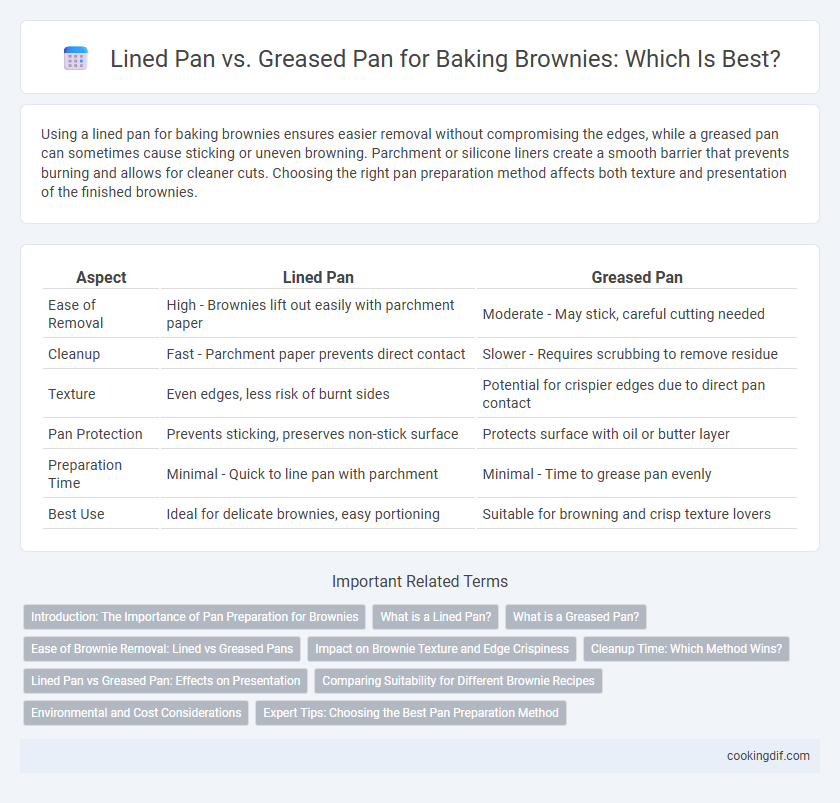Using a lined pan for baking brownies ensures easier removal without compromising the edges, while a greased pan can sometimes cause sticking or uneven browning. Parchment or silicone liners create a smooth barrier that prevents burning and allows for cleaner cuts. Choosing the right pan preparation method affects both texture and presentation of the finished brownies.
Table of Comparison
| Aspect | Lined Pan | Greased Pan |
|---|---|---|
| Ease of Removal | High - Brownies lift out easily with parchment paper | Moderate - May stick, careful cutting needed |
| Cleanup | Fast - Parchment paper prevents direct contact | Slower - Requires scrubbing to remove residue |
| Texture | Even edges, less risk of burnt sides | Potential for crispier edges due to direct pan contact |
| Pan Protection | Prevents sticking, preserves non-stick surface | Protects surface with oil or butter layer |
| Preparation Time | Minimal - Quick to line pan with parchment | Minimal - Time to grease pan evenly |
| Best Use | Ideal for delicate brownies, easy portioning | Suitable for browning and crisp texture lovers |
Introduction: The Importance of Pan Preparation for Brownies
Proper pan preparation is crucial for baking brownies to achieve the ideal texture and ease of removal. Using a lined pan with parchment paper prevents sticking and allows for clean edges, while a greased pan ensures a buttery crust but may cause uneven lifting. Selecting the right method affects the brownie's final appearance, moisture retention, and overall quality.
What is a Lined Pan?
A lined pan for baking brownies is typically a baking dish covered with parchment paper or aluminum foil to prevent sticking and ensure easy removal of the brownies. This technique creates a non-stick barrier that helps maintain the integrity of edges and corners, resulting in cleaner slices. Using a lined pan also reduces the need for excessive greasing, promoting even baking and simplifying cleanup.
What is a Greased Pan?
A greased pan is a baking container coated with butter, oil, or non-stick spray to prevent brownies from sticking to the surface. This method ensures easy removal and maintains the texture of the edges, promoting even baking. Unlike lined pans that use parchment paper for easy lift-out, greased pans rely solely on the fat layer for non-stick properties.
Ease of Brownie Removal: Lined vs Greased Pans
Using a lined pan with parchment paper significantly enhances ease of brownie removal by preventing sticking and allowing the entire baked batch to lift out effortlessly. Greased pans, while reducing adhesion, often still cause edges to stick, requiring extra effort and increasing the risk of breaking brownies when removing them. For flawless, intact brownies, a lined pan remains the superior option for smooth, clean extraction.
Impact on Brownie Texture and Edge Crispiness
Using a lined pan for baking brownies ensures easier removal and a fudgier texture due to retained moisture, while a greased pan promotes a slightly crisper edge by allowing direct contact with the metal surface. The parchment or foil lining minimizes sticking without altering the brownie's internal softness, maintaining a moist center. Greased pans enhance Maillard reaction at the edges, resulting in a firmer and crunchier crust that contrasts with the chewy interior.
Cleanup Time: Which Method Wins?
Using a lined pan for baking brownies significantly reduces cleanup time since parchment paper prevents batter from sticking, allowing easy removal and minimal scrubbing. Greased pans often require more effort to clean due to residue buildup from butter or oil that sticks to the surface. Therefore, lined pans emerge as the superior choice for quicker and hassle-free cleanup after baking brownies.
Lined Pan vs Greased Pan: Effects on Presentation
Using a lined pan for baking brownies ensures clean edges and easy removal, resulting in a polished, professional presentation with minimal crumb breakage. In contrast, a greased pan may cause the brownies to stick or break apart during removal, leading to uneven edges and a less visually appealing final product. Lined pans also prevent excess grease on the brownie surfaces, enhancing the overall texture and look.
Comparing Suitability for Different Brownie Recipes
Lined pans provide a non-stick surface ideal for fudgy brownie recipes, allowing easy removal without breaking. Greased pans suit cakey brownies by promoting even browning and a slightly crisp crust. Choosing between lined or greased pans depends on the desired texture and moisture level of the brownie recipe.
Environmental and Cost Considerations
Using a lined pan with parchment paper reduces the need for excessive greasing, minimizing waste and lowering the environmental impact by cutting down on non-recyclable oils. Greased pans often require more oil or butter, increasing both ingredient costs and potential residue, which can contribute to more difficult clean-up and higher water usage. Lining pans also allows for easier removal of brownies, reducing damage and food waste, aligning with sustainable baking practices and cost efficiency.
Expert Tips: Choosing the Best Pan Preparation Method
Using a lined pan with parchment paper ensures easy removal of brownies, preventing sticking and maintaining clean edges, which is crucial for presentation. Expert bakers often prefer greasing the pan when aiming for a chewier crust, as the direct contact promotes a slightly crispier exterior. Balancing these methods depends on desired texture and cleanup convenience, with lined pans favored for uniform baking and greased pans enhancing crust development.
Lined pan vs greased pan for baking brownies Infographic

 cookingdif.com
cookingdif.com